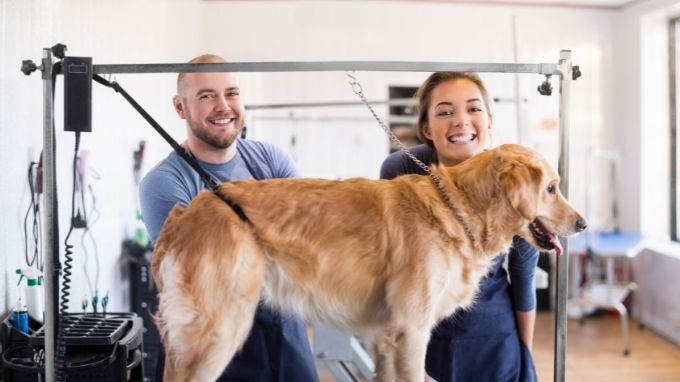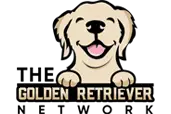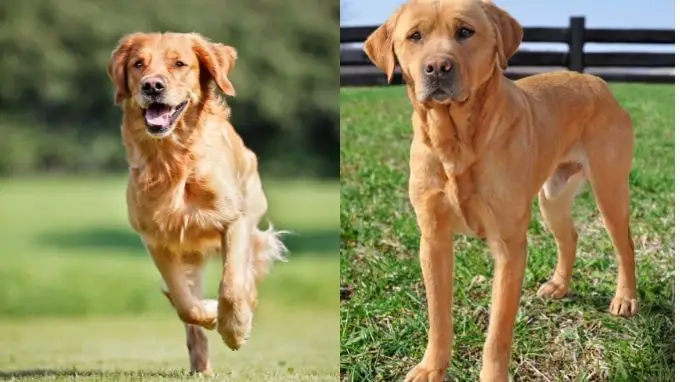Golden Retrievers are beautiful dogs and amazing companions. They are frequently ranked among the top three most popular dogs in America. Their luxurious and shiny coat makes them easy to spot among the many dogs we encounter every day. One question we hear a lot is whether there are Golden Retrievers with short hair. This is usually linked to a common fear about how much a golden retriever might shed and the thought that, if they had shorter hair, it might be less of an issue.
So, let’s find out…
Are There Short-Haired Golden Retrievers?
The short answer would be: no, there are no Golden Retrievers with short hair. At least, there are no purebred short-coated one. Dogs with short hair that look like Golden Retrievers may be a mix-breed or another type of retriever. These other breeds of retrievers can look and behave similarly.
Some of the breeds that can be mistaken as short hair retrievers are:
– English Springer Spaniel
– Bernese Mountain Dog-
– Labrador Retriever
– Flat-Coated Retriever
– Leonberger
– Great Pyrenees
– Chesapeake Bay Retriever
– Nova Scotia Duck Tolling Retriever
Pet owners who own a short-haired retriever can contact their breeder or shelter to confirm their dog is purebred. There is no need to worry, though. Golden Retrievers have excellent genes that produce great mix-breeds. Fur-parents only need to worry about that if they breed, register in clubs or enter dog shows, though.
What Are Golden Retrievers?
Retrievers are dogs that are bred as an answer to humanity’s advancement in hunting. For centuries, humans could only hunt fowl and game from a close range, thus making retrieving it an easy task. But as hunting tools became capable of longer range, the game would often fall farther and in water. Unfortunately, retrievers of that time were incapable of collecting games in such situations. Thus, they bred a new kind of dog.
They bred a yellow retriever with a now extinct Tweed Water Spaniel. The resulting litter of four became the pioneers of a new breeding program. This litter involved a bloodhound, St. John’s water dog of Newfoundland, two black retrievers and an Irish Setter.
These newly-bred retrievers were perfect for the new job. They were highly trainable, athletic and mild-mannered. Further, they instinctively loved the water and came equipped with a thick double-coat. Moreover, they also had a soft mouth that was capable of picking up the game without damaging it. Thus, the Golden Retriever was born.
Britain’s Kennel Club accepted Golden Retrievers for registration as “Flat Coats” in 1903. Then in 1925, America followed suit and approved the breed. They created the American Golden Retriever Club in 1938.
The Golden Retrievers of Today
Goldens have evolved beyond being hunting dogs. Their mellow and trainability has also earned fame through television and film appearances. In addition, they are quite reliable helpers, which makes them such popular guide dogs. It is what led Goldens to take first in the AKC obedience trials in 1977.
Many Golden Retrievers are used for search and rescue. Their acute sense of smell and tracking abilities aid them in searching for missing people. They took part in the search-and-rescue during massive hurricanes, like Rita and Katrina. They also played a huge role in the hunt for survivors on 9/11.
Goldens are also popular pets among celebrities like Oprah Winfrey and Adam Levine. Even President Ford and President Reagan had one.
3 Types of Golden Retrievers
This is one of the most common questions about Golden Retrievers. Do they come in different varieties? Do they have different types? Yes, they do. There are two ways that Goldens can differ from each other: the first being by “type.”
There are three types of Golden Retrievers: America, British, and Canadian Golden Retrievers. Although, they have minimal differences that do not affect their health and temperament. Below is a breakdown of their disparities.
| American | British/English | Canadian | |
| Height | Males: 23″ to 24″Females: 21.5″ to 22.5″ | Males: 22″ to 24″Females: 20″ to 22″ | Males: 23″ to 24″Females: 21.5″ to 22.5″ |
| Weight | Males: 65 to 75 lbsFemales: 55 to 65 lbs | Males: 65 to 75 lbsFemales: 50 to 70 lbs | Males: 65 to 75 lbsFemales: 55 to 65 lbs |
| Coat | Long, dense, wavy and water-repellent | Flat, wavy and has feathering | Darker, shorter and thinner |
| Physique | Lankier and less muscular | Solidly built, heavier | Broad, well-defined |
| Breed Standard | Rich shades of gold, not too pale or too dark | Allows for cream coats | Allow for all shades of gold |
Differences in Physical Characteristics
While English Cream Golden Retrievers have shorter hair, they do not shed less than their American and Canadian cousins.
The second factor in which Goldens differ is by color. Goldens are known for their luxuriant locks, which come in a variety of golden hues. Between Goldens, there is little color difference. Unlike Labrador retrievers, Golden Retrievers tend to stick to a limited color palette.
The American Kennel Club only allows Golden Retrievers if they are lightly, perfectly or dark golden (but not red). British and Canadian Kennel Clubs, however, accept more coat colors, including cream.
Despite the attractiveness of the gold hue, some Goldens do not fall inside this spectrum. Golden Retriever colors can range from pure white to mahogany, red and even black. They are not as common as they once were, but they are still found.
All Golden Retrievers, regardless of variety, have a similar temperament. For new dog owners, they are an excellent choice since they are easily trainable. Also, they are loving and affectionate, as long as their fur parents treat them right.
At What Age Do Golden Retrievers Grow Hair?
Golden Retriever puppies have hair at the start of their life like most dogs. Although, the adult coat comes in at about three months of age. After this, it will only grow longer. Next, light hair on their tail, known as feathering.
These growths are visible as they are darker than the puppy’s light hair. At eight months, the feathering becomes more prominent. After a year, it will be entirely noticeable. Goldens are considered fully grown by two years.
Golden Retrievers, unlike most other breeds, do not lose their puppy fur. Instead, the longer adult hair grows on top of the puppy hair, pushing the puppy hair away. As a second layer of fur, the puppy hair becomes the dog’s undercoat. The undercoat thickens with time as the longer outer coat comes in. This entire process takes around 18 months for their stunning fur to finish growing.
Can You Keep Golden Retriever Hair Short?
Yes, Golden Retrievers’ hair can be short through trimming. But it is crucial not to trim their coat anywhere other than specific areas, like their paws, toes and ears. It is best if Goldens are brought to a professional groomer. Pet owners may want to get these areas trimmed for the following reasons:
| Paws and Toes | The dirt easily gets into these areas, so they should be short and smooth to the surface. |
| Ears | Hair build-up in and around the ears could block the ear canals. It can also lead to infections or irritation. |
| Legs | Keeping the hair close to their body cuts down on the amount of dirt they can collect when walking around. The goal of trimming is to remain symmetrical. |
Pet owners do not need to worry. Goldens naturally shed to keep the equilibrium in their coat. So, it is best never to shave a Golden’s coat, as it will not stop shedding. Worse, the Golden’s coat will be permanently damaged and will never grow back the same.
Fur parents who are looking to get a Golden Retriever may be discouraged from their fur shedding. But, shedding is unavoidable, and they may shed throughout the year. It may even be heavier with the changing of seasons. However, pet owners can help keep it under control.
1. Frequent Brushing
Brushing at least once a week removes Golden’s excess hair in a controlled manner. It can also help pet owners check their dog’s skin for any ticks, abrasions, or issues they need to address. Goldens also love the feeling and extra attention, so they are sure to accept it into their routine fast.
2. Regular Bathing
The majority of Goldens adore baths, and it is an effective hair-management approach. When the dog is bathed, fur soon to be shed will be washed away, as well as those that are still clinging to their coat. Keep in mind not to bathe Goldens too often, as this can cause skin and coat problems.
3. Feed Only High-Quality Food
All dogs should be fed healthy and nutritious dog chow. An appropriate, high-quality diet is vital for a Golden Retriever’s skin and coat. As a result, they will be less likely to shed more hair than they should.
4. Lessen Their Stress
Because stress and worry can increase the pace at which Goldens shed, it is critical to keep them healthy. Fur parents can do this in part by giving them plenty of opportunities to exercise and a lot of attention. In addition, good dog toys can keep them engaged and allow them to exercise their chewing instincts.
5. Go Swimming
Swimming is a terrific way for most Goldens to get some exercise. Also, Goldens instinctively love the water. If you’re taking them swimming outdoors, make sure to bathe them after. Lake and river water can expose dogs to germs and other infections. Even in swimming pools, dogs should still be bathed after swimming to rinse the chlorine off their fur.
6. Give Them A Comfy Bed
Goldens most likely will shed most in the area where she spends more time in. So, a comfortable bed in a safe space can reduce the shedding near or on your furniture.
7. Color Match Your Stuff
Color matching furniture with a dog may not reduce their shedding, but it can make it seem like it does. Colors that match your Golden Retriever’s coat can make the fur shed seem invisible. The sight of this can help relieve stress for some time. Of course, fur parents are not expected to buy new furniture to match their pup. Covers for the couch and other furniture can be enough.

Why Should You Get a Golden Retriever?
Granted, Golden Retrievers need a lot of attention. But when fur parents adopt one, they will find that it’s worth it. They are huge, huggable balls of fluff that return every bit of love given to them. Here are a few reasons why Goldens are perfect for experienced and new dog owners alike.
- They are loving, calm and also good-natured balls of fur.
- Their intelligence makes them easy to train. Goldens’ size, speed and agility also make training fun.
- They are very pack-oriented, so they love being part of a family. The bigger, the better.
- They adapt fast to other pets at home.
- Goldens are extremely energetic, so it seems the household has a puppy forever.
- They do not bark or bite much.
However, bringing a Golden Retriever to the pack at home may not be a walk in the park for some. So here are some watch-outs before getting a Golden.
- They get big and get hungry.
- They are hunting dogs, so they need a lot of exercise. It is recommended they get an hour of vigorous exercise, lest they get restless and chewy.
- Of course, there’s the shedding. But this guide can keep fur shedding under control.
- Goldens are not built to be alone at home. It can give them undue stress and depression. Rather, they thrive on companionship and play.
- They are prone to some health problems, including hip dysplasia, cataract and hypothyroidism.
They deserve every bit of love and care because they will be giving back that love tenfold. Goldens have an extensive list of needs. If these concern potential fur parents, then they might need to rethink getting one.
Final Thoughts
While there are no Golden Retrievers with short hair, they are still great dogs to have around. This guide can be a reminder for potential Golden owners that shedding is manageable. To sum up , Golden Retrievers are worth every effort put into them. They are great with kids, other pets and other people, making them a great addition to all kinds of families.

